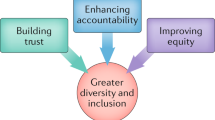Abstract
Researchers who propose projects about the human past frequently fail to distinguish between scientific value and the impact of both the proposal and the possible outcome for participant groups. It is only in recent years, and still in relatively few cases, that Aboriginal Australians have been directly involved in projects about themselves. The legacy of previous research experiences is a lingering distrust of ‘white’ researchers who visit communities briefly, take material/information, publish papers, and are rarely seen again. This distrust is understandable but in turn becomes a barrier which many well-intentioned researchers are unable or unwilling to overcome. The expectations of the scientific community, particularly in the field of molecular biology, simply do not make allowances in terms of time or funding to build a trusting relationship between the researchers and the researched.
Sensitivity to indigenous rights and expectations with regard to scientific research brings obligations to scientific investigators with which few are well prepared to deal. The direct involvement of indigenous people in research about themselves is essential to the development of trusting working relationships likely to result in valuable outcomes for all participants and increased opportunities for ongoing research.
Well negotiated, co-operative research can provide information of value to both scientific investigators and local participants, but adequate and ongoing consultation, as well as the return of results to the communities in an accurate and appropriate form must be part of research strategy. For example, information about mitochondrial DNA studies may assist Indigenous Australian people, whose families were dispersed during colonisation by Europeans, to trace links with the past, find ‘stolen children’ and by association with other anthropological, linguistic and archaeological data, repossess some remnants of traditional knowledge, but researchers must ensure that participants have a realistic understanding of the limitations of the research.
Similar content being viewed by others
References
Allen H R 1974. Where the crow flies backwards: man and land in the Darling Basin. PhD thesis, Department of Prehistory, Research School of Pacific Studies, Australian National University, Canberra.
Bowler J M, Jones R, Allen H, Thorne A G (1970) Pleistocene human remains from Australia: a living site and human cremation from Lake Mungo, western New South Wales. World Archaeology 2:39–60.
Charlesworth M (Ed) (1998)Religious business. Essays on Australian Aboriginal Spirituality. Cambridge University Press.
Dodson M and williamson R 1999. Indigenous peoples and the morality of the Human Genome Diversity Project.Journal of Medical Ethics 24:203–208.
Foster M W, Bernsten D, Carter T H, 1998. A model agreement for genetic research in socially identifiable populations. Am J Hum Genet 63:696–702.
Goodall H (1996) Invasion to embassy.Land in Aboriginal politics in New South Wales, 1770–1972. Allen and Unwin in association with Black Books, Australia.
Hardy B (1976) Lament for the Barkindje: the vanished tribes of the Darling River region. Rigby Australia.
Hercus LA (1993) Paakantyi dictionary. Produced with the assistance of the Australian Institute of Aboriginal and Torres Strait Islander Studies, Canberra, ACT pp 2–18.
Horton D (gen. ed) (1994)The encyclopaedia of Aboriginal Australia. The Australian Institute of Aboriginal and Torres Strait Islander Studies, Canberra, ACT.
Horton D 1996 Map ‘Aboriginal Australia’ as in Horton D (gen. ed) (1994) The encyclopaedia of Aboriginal Australia. The Australian Institute of Aboriginal and Torres Strait Islander Studies, Canberra, ACT.
Human Rights and Equal Opportunity Commission 1997Bring them home. National Inquiry into the separation of Aboriginal and Torres Strait Islander children from their families. Commonwealth of Australia.
Lum JK, Rickards O, Ching C, Cann RL (1994) Polynesian mitochondrial DNAs reveal three deep maternal lineage clusters.Hum Biol 66:567–590.
NHMRC (1991)Guidelines on ethical matters in Aboriginal and Torres Strait Islander health research. National Health and Medical Research Council, Canberra, ACT.
Pattel-Gray, A (1996)Aboriginal Spirituality past present and future. HarperCollins Religious, Blackburn.
Rainbow Spirit Elders (1996) Rainbow Spirit theology: toward and Australian Aboriginal theology. HarperCollins Religious, Blackburn.
Redd AJ, Takezaki N, Sherry ST, McGarvey ST, Sofro ASM, Stoneking M (1995) Evolutionary history of the COII/tRNALys intergenic 9 base pair deletion in human mitochondrial DNAs from the Pacific. Mol Biol Evol 12(4):604–615.
Reynolds, H 1987 Frontier. Aborigines, settlers and land. Allen and Unwin, Australia.
Thorne A, Grun R, Mortimer G, Spooner N A, Simpson J, McCulloch M, Taylor L, Curnoe D 1999. Australia’s oldest human remains: age of the Lake Mungo 3 skeleton. Jornal of Human Evolution 36(6):591–612.
van Holst Pellekaan SM (1993) “The Process of Consultation with Aboriginal Communities regarding Biomedical and AnthropologicalResearch.Proceedings of Australian Bioethics Association Annual Conference 26–28 November, Women’s College, Sydney University Vol 111 p 1–8.
van Holst Pellekaan, S., Frommer, M., Sved, J. and Boettcher, B. (1997) Mitochondrial D-loop Diversity in Australian Riverine and Australian Desert Aborigines. Proceedings of 4th International DNA Fingerprinting Conference, Melbourne December 2–7, 1996.Electrophoresis 18:1538–1543.
van Holst Pellekaan, S (1997b)Patterns in DNA passed by our mothers; what does this mean for the Aboriginal people of the Darling River region? (A report to the communities produced by the author).
van Holst Pellekaan, S. M., Frommer, M., Sved, J. A. and Boettcher B. (1998) ‘Mitochondrial Control-Region Sequence Variation in Aboriginal Australians’American Journal of Human Genetics 62:435–449.
van Holst Pellekaan S M 1999 in press.
Vigilant L, Pennington R, Harpending H, Kocher TD, Wilson AC (1989) Mitochondrial DNA sequences in single hairs from a southern African population.Proc Nat Acad Sci USA 86:9350–9354.
Author information
Authors and Affiliations
Rights and permissions
About this article
Cite this article
van Holst, P.S. Human genome diversity: Ethics and practice in Australia. Hum. Evol. 19, 131–144 (2004). https://doi.org/10.1007/BF02437499
Received:
Accepted:
Issue Date:
DOI: https://doi.org/10.1007/BF02437499




